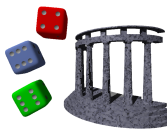What is this place?
Delarosa Manor is a lamination, a series of psychic/spiritual planes built around a temporary place of power. Because it uses psychic/spiritual power, the laminae are potentially infinite, drawing on the psychic health of the people in its grip to feed the emotional demon at its core.
The place of power was drawn forth by a mass murder, with Louis Merrikitt performing the spirit manifestation, and captured slaves and infants in the marsh, bought from pirates, providing the deaths.
Why are the players here?
1. They are hired to retrieve a child, woman, or person who went in previously. That person is now a ghost.
2. They are hired to retrieve some item lost inside by a previous team, all of whom either went crazy or died. These may also be ghosts—or be called in by the house even though they’re still alive.
3. They are hired by the current heir to find treasure.
4. They are scouting the house for its current owners.
Running this adventure: Stages
1. Hand out the handouts and describe the rules.
2. Leave Crosspoint to King’s Head.
3. King’s Head to Delarosa Manor.
4. Meet Farmer Giles.
5. Delarosa Manor.
6. T-90 minutes: Steffan starts to come to kill them, with whatever assistance (cranes, fetal spiders, goldwing harriers) is coolest. They will hear heavy steps; the house will breathe. Blood seeps from the walls.
What about the movies?
This is a role-playing adventure, not the movies. In the movies that inspired this adventure, the protagonists do blatantly stupid things such as sleep alone in a haunted house even after the house tries to kill them. Your players are likely to play smarter than that, and that’s good. Let the house adapt to these smarter victims, and allow the players the thrill of playing through a horror “movie” where they are in control of the roles.
Holy water vs. blessed water
If the players think ahead, they’ll have their characters bring holy water, or, if they have a prophet, blessed water. (Along the first level, of course, the players can have had their characters think ahead.)
Undead take 2d4 points of damage from blessed water, that is, water blessed by a prophet with the bless spirit manifestation. Demons take d6 points of damage from blessed water. If used as part of a called attack, one point from each die is an injury.
Most holy water in a temple or church has not been blessed by a prophet. It is the result of a holy rite, performed by a priest who is not a prophet. This holy water causes one point of damage to undead and demons, and may also be used in a called attack to turn it into an injury.
Holy water must have been created by a priest of a real religion; what constitutes a real religion will depend on what gods are in your game, but most likely it will require some combination of worshipping real gods that have worshippers who take the gods and the priest seriously.
Inspiration
No living organism can continue for long to exist sanely under conditions of absolute reality; even larks and katydids are supposed, by some, to dream. Hill House, not sane, stood by itself against its hills, holding darkness within; it had stood so for eighty years and might stand for eighty more. Within, walls continued upright, bricks met neatly, floors were firm, and doors were sensibly shut; silence lay steadily against the wood and stone of Hill House, and whatever walked there, walked alone.
Thus Shirley Jackson began The Haunting of Hill House. Many works about malleable haunted houses and malleable realities have inspired this adventure. The first such story I read was in issues 34 to 37 of Werewolf by Night in Marcosa House (available in Essential Werewolf by Night, volume 2). Doug Moench’s Marcosa House was heavily influenced by Richard Matheson’s Hell House (and the movie, The Legend of Hell House). Matheson was inspired by Shirley Jackson’s book which became the 1963 Robert Wise film, The Haunting.
Later, in college, I saw Phantasm, which was very influential on movies of this type. Stephen King has written several evil buildings, including The Shining (Stanley Kubrick’s adaptation is also inspirational), the short story 1408 (made into a great movie with John Cusack), and the Rose Red TV miniseries, a not-at-all disguised Hill House. While A Nightmare on Elm Street isn’t set in an evil building, it captures the fluid reality inside these evil houses. They’re very dream-like. Dario Argento’s Suspiria will also provide inspiration for the Adventure Guide.
Several years ago I toured the Winchester house in California, an odd bit of architecture which to some degree inspired Rose Red.
And, of course, there’s a lot to be said for Scooby Doo as well.
